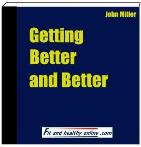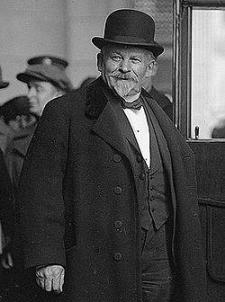
How would you like to get better and feel better?
Getting Better and Better is an audio file recorded by John Miller based on the famous piece of auto Suggestion from Emile Coué.
Coué found that getting people to sit quietly on their own and recite the mantra to themselves several times a day (just so that it was audible to them), was most helpful in overcoming a range of physiological and psychological issues.
The audio file begins with you relaxed and sitting in a chair. After being asked to close your eyes the audio takes you through a muscular relaxation exercise before repeating the mantra 20 times.
By the end of the session you’ll be relaxed and focused.
The relaxation part of the session is designed to calm down an over-stimulated sympathetic nervous system (the fight and flight system). Muscles relax, blood vessels dilate (so your blood pressure comes down) and brainwaves slow down almost to the point of going to sleep. You’ll be take to the alpha brain wave state of deep relaxation and suggestibility.
This is a most desirable state from which to start reciting the mantra.
Your subconscious knows what needs to get better; your subconscious has a fair idea of what you need to do for things to get better.
This audio file is the key to unlocking the power of your subconscious for things to get better and better.
Do you want things to get better?
This audio file is a powerful tool that can sharpen your own mental faculties so you start to get what you want.
Once you’ve learnt how to do this exercise you’ll be able to do it on your own, though having the audio file running is a good motivator to just sit, relax and focus.
The Better and Better audio file is available for immediate download.
The investment in your health and wellbeing: $17us.

Émile Coué (1857 – 1926) was a French psychologist and pharmacist who introduced a method of psychotherapy and self-improvement based on optimistic autosuggestion.
Coué’s method centers on repeating this piece of autosuggestion twenty times, several times a day.’Day by day, in every way, I’m getting better and better.’
Unlike a common held belief that a strong conscious will constitutes the best path to success, Coué maintained that curing some of our troubles requires a change in our subconscious thought, which can only be achieved by using our imagination. Although stressing that he was not primarily a healer but one who taught others to heal themselves, Coué claimed to have effected organic changes through autosuggestion.
Development and origins
Coué noticed that in certain cases he could improve the efficacy of a given medicine by praising its effectiveness to the patient. He realized that those patients to whom he praised the medicine had a noticeable improvement when compared to patients to whom he said nothing. This began Coué’s exploration of the use of hypnosis and the power of the imagination.
His initial method for treating patients relied on hypnosis. He discovered that subjects could not be hypnotized against their will and, more importantly, that the effects of hypnosis waned when the subjects regained consciousness.
Coué believed in the effects of medication. But he also believed that our mental state is able to affect and even amplify the action of these medications. By consciously using autosuggestion, he observed that his patients could cure themselves more efficiently by replacing their “thought of illness” with a new “thought of cure”. According to Coué, repeating words or images enough times causes the subconscious to absorb them. The cures were the result of using imagination or “positive autosuggestion” to the exclusion of one’s own willpower.
Underlying principles
Coué thus developed a method which relied on the principle that any idea exclusively occupying the mind turns into reality, although only to the extent that the idea is within the realms of possibility. For instance, a person without hands will not be able to make them grow back. However, if a person firmly believes that his or her asthma is disappearing, then this may actually happen, as far as the body is actually able to physically overcome or control the illness. On the other hand, thinking negatively about the illness (ex. “I am not feeling well”) will encourage both mind and body to accept this thought. Likewise, when someone cannot remember a name, they will probably not be able to recall it as long as they hold onto this idea (i.e. “I can’t remember”) in their mind. Coué realised that it is better to focus on and imagine the desired, positive results (i.e. “I feel healthy and energetic” and “I can remember clearly”).
Willpower
Coué observed that the main obstacle to autosuggestion was willpower. For the method to work, the patient must refrain from making any independent judgment, meaning that he must not let his will impose its own views on positive ideas. Everything must thus be done to ensure that the positive “autosuggestive” idea is consciously accepted by the patient, otherwise one may end up getting the opposite effect of what is desired.
For example, when a student has forgotten an answer to a question in an exam, he will likely think something such as “I have forgotten the answer”. The more he or she tries to think of it, the more the answer becomes blurred and obscured. However, if this negative thought is replaced with a more positive one (“No need to worry, it will come back to me”), the chances that the student will come to remember the answer will increase.
Coué noted that young children always applied his method perfectly, as they lacked the willpower that remained present among adults. When he instructed a child by saying “clasp your hands and you can’t open them”, the child would thus immediately follow.
Self-conflict
A patient’s problems are likely to increase when his willpower and imagination (or mental ideas) are opposing each other, something Coué would refer to as “self-conflict”. In the student’s case, the will to succeed is clearly incompatible with his thought of being incapable of remembering his answers. As the conflict intensifies, so does the problem: the more the patient tries to sleep, the more he becomes awake. The more a patient tries to stop smoking, the more he smokes. The patient must thus abandon his willpower and instead put more focus on his imaginative power in order to fully succeed with his cure.
Effectiveness
Thanks to his method, which Coué once called his “trick”, patients of all sorts would come to visit him. The list of ailments included kidney problems, diabetes, memory loss, stammering, weakness, atrophy and all sorts of physical and mental illnesses. According to one of his journal entries (1916), he apparently cured a patient of a uterus prolapse as well as “violent pains in the head”.
Harry Brooks (1890–1951), author of various books on Coué, claimed the success rate of his method was around 93%. The remaining 7% of people would include those who were too skeptical of Coué’s approach and those who refused to recognize it.
Medicines and autosuggestion
The use of autosuggestion is intended to complement the use of medicine, but no medication of Coué’s time could save a patient from depression or tension. Coué recommended that patients take medicines with the confidence that they would be completely cured very soon, and healing would be optimal. Conversely, he contended, patients who are skeptical of a medicine would find it least effective.
Source: Wikipedia – Émile_Coué
